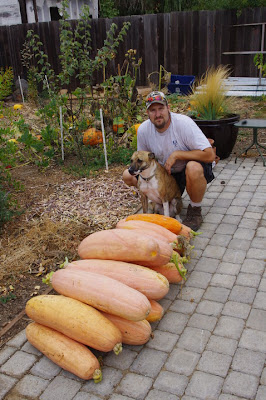 |
| This all came from one plant that we didn’t irrigate |
I’m going to learn how to do it. I’m considering dedicating one of our large 75′ beds to dry farming. I think that our soil might be cut out for it. I honestly don’t know much about it, but I’m going to start researching it.
For those that don’t know what dry farming is, it’s a technique of growing food, specifically corn, squash, potatoes, beans and tomatoes without using summer irrigation. Now some of you may think that’s no big deal, but here in California and much of the West, it does not typically rain between June and early October – which is also the prime growing season.
I never really considered dry farming until this past year when we had a TON of volunteer squash. I had assumed that squash needed a lot of water. As it turns out they didn’t. Our volunteer squash that we didn’t water actually did better than the squash that we did. Granted, some of it grew where the old chicken coop was so it had a TON of fertilizer, but it didn’t have water. When we pulled the plants out, they all had very large, deep and extensive root systems.
From what I’ve read, soil structure is the most important aspect to dry farming. It can’t be too sandy or else it won’t hold water long enough over the summer months. It has to be like a sponge to draw water up from the water table. It also has be mulched well after the last rains to avoid water evaporation. Most dry farmers use a 3-4″ layer of soil to create the barrier. I’m going to dry well composted bark mulch (we have a giant pile of it in our 2nd driveway).
Dry farming does not increase yields. Our squash did so well because of the soil fertility. That said, it does save significant amounts of water and is considered much more sustainable.


Dry farming? That is a new concept to me. But I see the huge amount of water going to Cape fruit trees and grape vines – dry farming sounds well worth trying. Those volunteers coming up from the compost are always happier stronger plants!
Yep, I had volunteer squashes up the wazzoo. (Note to self: don't feed squash guts to chickens, lest they 'plant' seeds everywhere.)
I got a couple jarrahdales off a volunteer vine as my queenslands and triambles just wimped along. And then I got some decent pumpkins while the potimarrons refused to produce any fruit despite eager carpenter bees.
The pumpkins were dry-farmed up until August, at which point I watered with laundry water mostly, when I was watering the fruit trees.
I wish I'd remembered to inoculate with mycorrhizae, because that network of fungus really keeps the soil moister beneath the surface.